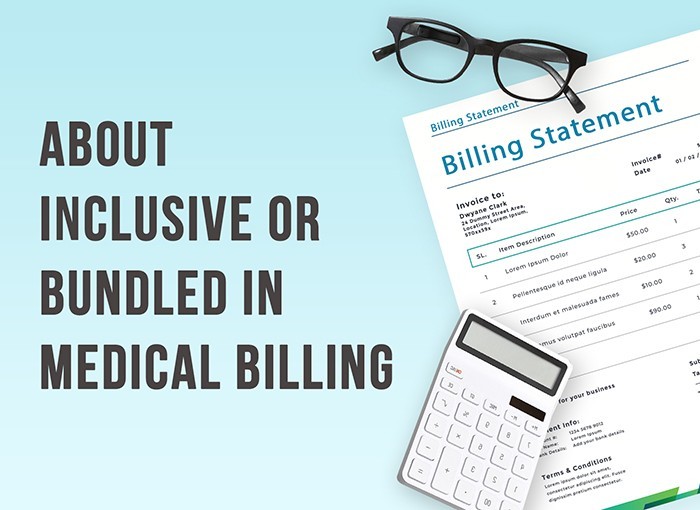What is bundled in medical billing ?
In the field of medical billing, the process of linking some services under a code is known as bundling. The design of bundled payments was conceived to facilitate payment for multiple providers who were engaged in providing care during the treatment period.
Under this model, all healthcare facilities or providers are remunerated a single payment for all the services performed in a particular course of care. For example: If the patient underwent surgery, traditionally the departments involved in the course of treatment are paid separately.
For instance, if the care: of a surgeon, anesthesiologist, and other general hospital staff is involved the payer will give a set price that is based on historical costs instead of paying each service provider separately.
The challenge with this model for healthcare providers is that if they exceed the pre-arranged reimbursement for the episode they have to bear the financial burden of the excess resources spent for the treatment. On the other hand,d if the cost of the treatment is less, then the providers get to keep the difference.
Moreover, there can be situations where the bundled payment model may be inappropriate as the factors which are largely influencing the price difference are not in the control of the healthcare provider. Another issue is a technological one wherein healthcare providers do not have advanced technology for comprehensive data collection and reporting.
How Does Bundling Work?
Bundled payments assign one fixed price for all the care provided during a specific treatment or recovery period. If the cost of care exceeds this amount, the healthcare providers must cover the extra expenses. However, if the total cost is lower, the providers keep the difference.
While bundling can make billing more straightforward, it comes with challenges. For instance:
- Providers might face financial risks if unexpected complications drive up the costs.
- Some treatments might not fit well into this model due to unpredictable factors like patient health conditions.
- Providers need advanced technology to track and manage data effectively, which not all organizations have.
Why Use Bundled Billing?
Bundling benefits both patients and healthcare providers by:
- Reducing Costs: It encourages healthcare teams to avoid unnecessary procedures, saving money.
- Improving Collaboration: A single payment pushes providers to work together for better outcomes.
- Simplifying Billing: Patients get clearer, more predictable bills, reducing financial surprises.
Challenges in Bundled Payments
Although bundling simplifies billing, it isn’t always straightforward. Here are some common hurdles:
- Financial Risk: If care costs go beyond the set payment, providers lose money.
- Inappropriate Usage: Some treatments are too variable for bundled pricing.
- Technology Gaps: Many providers lack the tools needed to track costs and outcomes efficiently.
How can you succeed with bundled billing?
The key to success with bundled billing is to improve provider communication within departments as well as the healthcare organization overall. This can be done by executing effective care coordination which ensures that all treatments meted out to the patients are necessary and are utilizing the resources optimally. Early communication between groups who will be needed for the particular course of treatment or the ones who are setting the same is essential.
Everyone from the early treatment providers to surgeons and post-treatment hospital staff need to be on the same page. By ensuring this they will be working on the same lines although at different times. The shared understanding is critical to manage the cost of the entire exercise as a set plan which contains cost break-ups will eliminate use of extra resources that will drive up the cost.
Providers also need to classify patients according to their condition and the cost of their treatment. This can be done by categorizing patients based on their sickness as well as the amount of resources, time, and medication that will be needed to treat them.
This exercise can be executed well by predicting what the patient’s needs will be throughout treatment after the initial diagnosis and then ensuring that all the right resources are provided for the best outcome.
The use of data analytic tools can also work for healthcare providers as they will be able to analyze both the quality of treatment needed and the cost of care to predict future outcomes which will ensure the right care is provided to each patient in a cost-efficient manner.
Examples of Bundled Payment Models
To encourage value-based care, initiatives like the following have been introduced:
- Comprehensive Care for Joint Replacement (CJR): Bundled payments for hip and knee surgeries-to encourage coordination with and within the care and decrease costs
- Bundled Payments for Care Improvement (BPCI): It covers a variety of medical conditions, motivating the provider to improve care quality.
- BPCI Advanced: A voluntary program with performance-based bonuses featuring its bundled care.
Key Steps for Implementation
To implement bundled billing successfully, healthcare providers should:
- Analyze Costs
Understand all the expenses involved in a treatment episode to set realistic bundled payment amounts. - Engage the Team
Involve doctors, nurses, and administrative staff in planning and execution to ensure everyone is aligned. - Focus on Quality
Regularly review and improve care processes to maintain high-quality standards and patient satisfaction.
Conclusion
Bundled payments are the cutting-edge in billing for healthcare facilities. It makes things easier, cuts the cost, and encourages collaboration among providers. Although there are challenges, bundled billing can improve patient care and financial outcomes with the right planning, communication, and tools.
Moving healthcare organizations such as the Health Care Systems towards value-based care with the adoption of this model benefits all.



